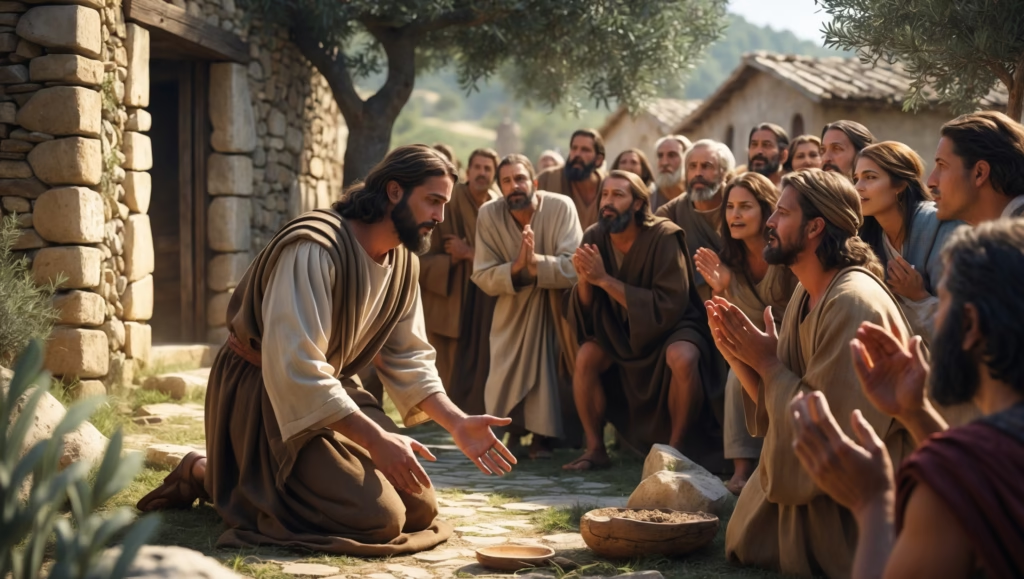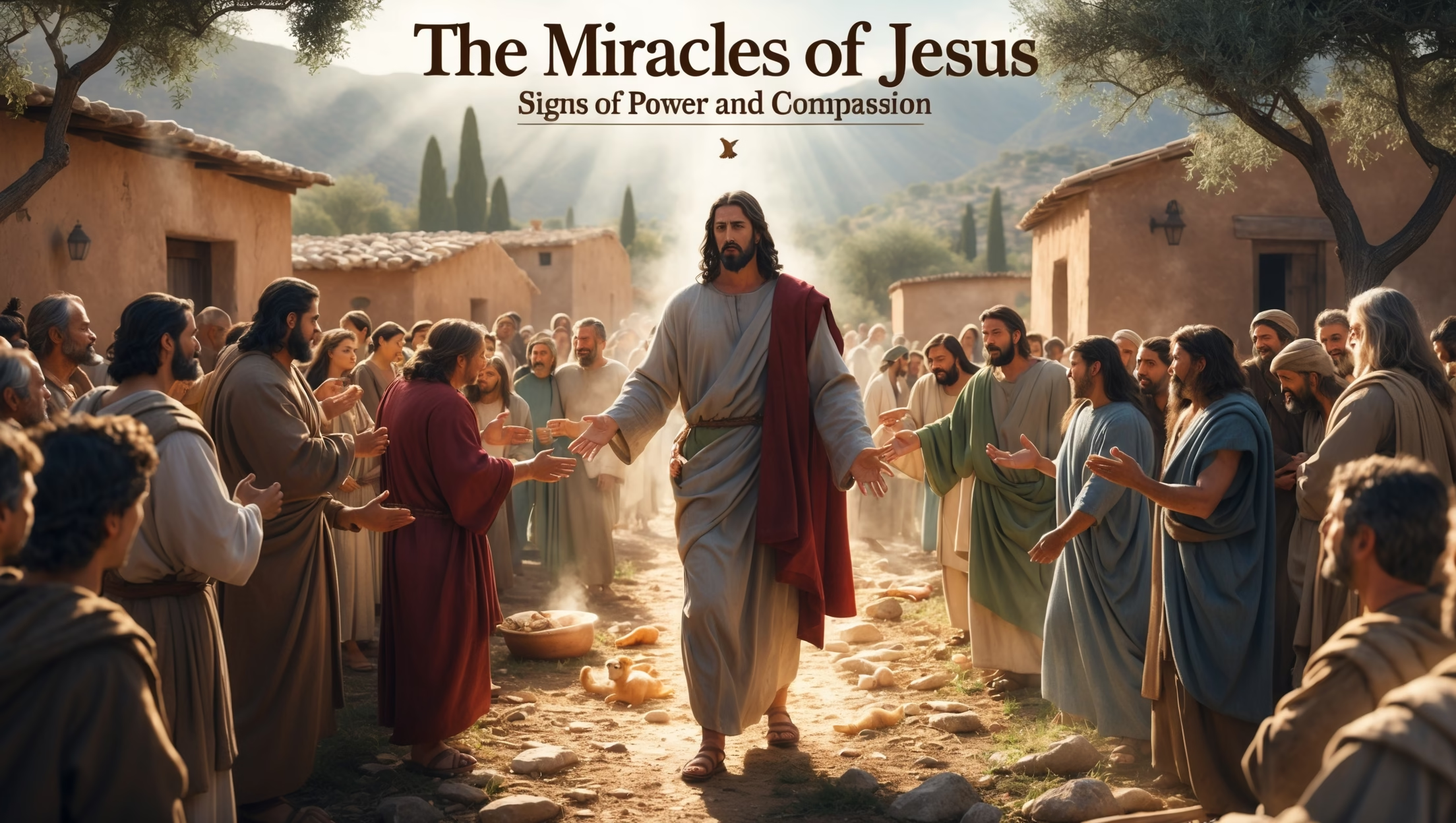Introduction
The miracles of Jesus are among the most compelling demonstrations of His divine nature and compassionate heart. They were not mere displays of supernatural ability but acts filled with purpose, pointing to God’s Kingdom and revealing His mercy. Each miracle illustrated both Jesus’ authority over nature, disease, and spiritual forces, and His deep care for human need. They were signs meant to inspire faith, transform lives, and provide a foretaste of the wholeness that God intends for creation.

Miracles of Healing
Healing formed a central part of Jesus’ ministry. He restored sight to the blind, enabled the lame to walk, cleansed lepers, and even raised the dead. These acts went beyond physical restoration; they restored dignity, community, and hope. For example, when Jesus healed the paralytic (Mark 2:1-12), He not only removed physical limitations but also addressed the man’s spiritual need by forgiving his sins. Each healing miracle emphasized that God is concerned with every dimension of human suffering, illustrating the holistic nature of divine care.
Miracles of Provision
Jesus also performed miracles of provision that demonstrated God’s abundant generosity. Feeding the five thousand (Matthew 14:13-21) and turning water into wine at Cana (John 2:1-11) showed that God cares about practical needs and the joys of life. These miracles reveal that God’s Kingdom is not only spiritual but also tangible, addressing hunger, celebration, and everyday necessities. They remind believers that God provides abundantly and invites trust in His provision.
Miracles Over Nature
Jesus’ authority extended over creation itself. Calming the storm (Mark 4:35-41) and walking on water (Matthew 14:22-33) displayed His mastery over natural forces, demonstrating that nothing is beyond His control. These miracles encouraged His followers to trust Him in the midst of life’s chaos and uncertainty. They also pointed to His divine identity, confirming that He is intimately connected to the Creator of all things.
Miracles of Deliverance
Deliverance miracles highlight Jesus’ victory over spiritual oppression. By casting out demons, He liberated individuals from bondage, restoring freedom, peace, and dignity. These acts symbolized the coming of God’s Kingdom, where evil is confronted and defeated. For instance, the healing of the Gerasene demoniac (Mark 5:1-20) showcased both Jesus’ authority over spiritual forces and His concern for marginalized individuals, demonstrating that God’s power brings both physical and spiritual restoration.
The Purpose of Miracles
Jesus’ miracles were not performed merely to impress or awe onlookers. Their true purpose was to reveal His identity as the Messiah, inspire faith, and point people toward God. Miracles often prompted reflection, confession, and belief, showing that divine power and mercy are inseparable. They illustrated the Kingdom of God breaking into the world, offering a glimpse of the wholeness and restoration that God promises to all who follow Christ.
Conclusion
The miracles of Jesus are enduring signs of His compassion, authority, and divine identity. They demonstrate God’s concern for physical, emotional, and spiritual needs and encourage believers to trust in His power and care. Through His miracles, Jesus revealed the heart of God, inviting faith, transformation, and hope in a world often marked by suffering. Each miracle continues to remind us that nothing is impossible with Him, and His compassion is limitless.
Focus Keywords:
jesus miracles, jesus healing miracles, jesus feeding five thousand, jesus calming storm, jesus miracles meaning
The Sermon on the Mount: Radical Teachings for Life
Introduction
The Sermon on the Mount, recorded in Matthew 5–7, is a cornerstone of Jesus’ teaching. It outlines the values of God’s Kingdom and challenges believers to live in ways radically different from worldly norms. Through this sermon, Jesus presents a vision for a life marked by humility, love, and integrity, offering both instruction and inspiration for daily living.
The Beatitudes
Jesus began with blessings for the poor in spirit, the meek, the merciful, and the peacemakers (Matthew 5:3-12). These statements overturn conventional notions of success, revealing God’s heart for humility, righteousness, and dependence on Him. Each beatitude emphasizes the spiritual attitudes valued in God’s Kingdom, providing encouragement and hope for those marginalized or struggling in the world.
Teaching on the Law
Jesus reinterpreted the law, emphasizing its spirit rather than mere external compliance. He taught that anger toward another equates to moral failure, and lustful thoughts carry the weight of sin (Matthew 5:21-30). This approach calls for inner transformation, showing that God desires hearts aligned with His will rather than mere outward obedience.
Prayer, Fasting, and Giving
In teaching spiritual disciplines, Jesus emphasized sincerity over public recognition. He instructed followers to pray privately, fast without drawing attention, and give with humility (Matthew 6:1-18). The Lord’s Prayer provides a timeless model, guiding believers to focus on God’s name, kingdom, provision, forgiveness, and protection. These teachings encourage an authentic, heart-centered faith.
Love for Enemies
One of the most radical elements of the sermon is Jesus’ command to love enemies and pray for persecutors (Matthew 5:43-48). This teaching embodies God’s boundless love, challenging believers to transcend natural inclinations toward resentment and retaliation. Loving enemies reflects the nature of God and is a hallmark of life in His Kingdom.
Building on the Rock
Jesus concluded by urging listeners to put His words into practice, likening obedience to a wise builder who constructs on solid rock (Matthew 7:24-27). This metaphor underscores the importance of integrating faith with action, ensuring that life is resilient in the face of trials.
Conclusion
The Sermon on the Mount presents a radical blueprint for living according to God’s Kingdom values. Its teachings challenge believers to embody humility, love, mercy, and integrity in a world often guided by self-interest. By applying these lessons, followers of Christ can experience transformative faith and become authentic witnesses of God’s Kingdom.









